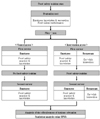1. Korea Foodservice Information. Korea Foodservice Statistical Yearbook. 2006. Seoul: Korea Foodservice Information;525–540.
2. Institute of Korea Rural Economics. Current Status and Improvement Plan of Statistics in Foodservice Industry. 2005. Seoul: Institute of Korea Rural Economics;91–97.
4. Ko HS, Kim SK, Kim DK, Kim BJ. Importance perception on the sanitation and cleanliness of family restaurant employees. Korean J Food Cookery Sci. 2005. 21:155–162.
5. Yoon JY, Moon HK. Job satisfaction and business attitude of restaurant owners - focused mainly in the Gyeongnam area -. Korean Journal of Community Nutrition. 2003. 8:610–620.
6. The Korea Food Drug and Administration. Strategic Plans for Preventing Foodborne Illness. 2008. Seoul: The Korea Food Drug and Administration;1–80.
7. Bryan FL. Factors that contribute to outbreaks of foodborne disease. J Food Prot. 1978. 41:816–827.

8. Koopmans M, Duizer E. Foodborne viruses: an emerging problem. Int J Food Microbiol. 2004. 90:23–41.

9. Kim YH, Choi HJ. The effects of job training service recovery, job satisfaction and turnover intention among service industry employees in Daegu and Daejeon. Tourism Science Studies. 2009. 33:317–342.
10. Kim ST, Park JY, Kam S, Han CH. Knowledge and attitude toward restaurant-related sanitation of new restaurateurs. Journal of Korean Society for Health Education and promotion. 1998. 15:79–95.
11. Chang HJ, Lee JS, Kwak TK. Effectiveness of HACCP-based training on the food safety knowledge and behavior of hospital foodservice employees. Nutr Sci. 2003. 6:118–126.
12. Walker E, Pritchard C, Forsythe S. Food handlers' hygiene knowledge in small food businesses. Food Control. 2003. 14:339–343.

13. Tokuc B, Ekuklu G, Berberoglu U, Bilge E, Dedeler H. Knowledge, attitudes and self-reported practices of food service staff regarding food hygiene in Edirne, Turkey. Food Control. 2009. 20:565–568.

14. Howes M, McEwen S, Griffiths M, Harris L. Food handling certification by home study: Measuring changes in knowledge and behavior. Dairy, Food and Environment sanitation. 1996. 16:737–744.
15. Noh JM. Field assessment of microbiological quality of restaurant operations and development of a sanitation training manual (master's thesis). 2006. Seoul: Yonsei University.
16. Kim SJ. Assessment of sanitation management and development of self-managed sanitation module for Korean food restaurants (master's thesis). 2005. Seoul: Yonsei University.
17. Choi JH. An education and training cases study for the implementation of HACCP system for school foodservice operations (master's thesis). 2000. Seoul: Yonsei University.
18. Ryu ES, Chang HJ. Food sanitary practices of the employees in university and industry foodservices. Journal of Korean Society Food Science. 1995. 11:274–281.
19. Eo GH, Ryu K, Park SJ, Kwak TK. Need assessments of HACCP-based sanitation training program in elementary school foodservice operations based on sanitation knowledge test of Employees. Journal of the Korean Diet Association. 2001. 7:56–64.
21. The Korean Food and Drug Administration. The Korean Food Code: HACCP. 2005. Seoul: The Korean Food and Drug Administration;1–50.
22. Kwak TK, Lee KM, Chang HJ, Kang YJ, Hong WS, Moon HK. Analysis of critical control points through field assessment of sanitation management practices in foodservice establishments. Korean Journal of food and cookery Science. 2005. 21:290–300.
23. Ministry of Education and Human Resources Development. Guidelines of Sanitation Management for School Foodservice Operations. 2004. Seoul: Ministry of Education and Human Resources Development;1–90.
24. Rivas KD, Canter DD. Effectiveness of talent for training school foodservice employee. School Foodservice Research Review. 1982. 6:113.
25. McCartan C, Perryman S. Evaluation of a nutrition education and training (NET) workshop for school personnel. School Food Service Research Review. 1982. 6:109.
26. Kwak TK, Cho YS, Lee HY. Evaluation of the food sanitation training program in child-care centers. Korean J Food Cult. 1994. 9:251–257.
27. Collins JE. Impact of changing consumer lifestyles on the emergence/reemergence of foodborne pathogens. Emerg Infect Dis. 1997. 3:1–13.

28. Lee YJ. A comparative study on sanitary practices and perception of employees in elementary school hospital and industry food service in the Inchon area. Journal of the Korean Diet Association. 2003. 9:22–31.
29. Ehiri JE, Morris GP. Evaluation of food hygiene training course in Scotland. Food Control. 1997. 8:137–147.

30. Angelillo IF, Viggiani NMA, Rizzo L, Bianco A. Food handlers and foodborne disease-knowledge, attitudes, and reported behavior in Italy. J Food Prot. 2000. 63:381–385.

31. Kim SJ, Yi NY, Chang HJ, Kwak TK. Current status of sanitation management performance in Korean-Food restaurants and development of the sanitary training posters based on their risk factors. Korean J Food Cult. 2008. 23:582–594.




 PDF
PDF ePub
ePub Citation
Citation Print
Print











 XML Download
XML Download